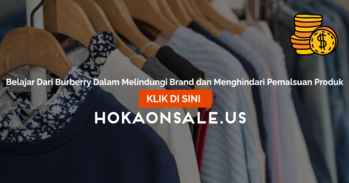
Learning from Burberry on Protecting Brands and Avoiding Counterfeits
Created on 4 July, 2024 • Marketing & Business Communication • 154 views • 2 minutes read
A brand is an intangible asset for a company, and its value can far exceed that of tangible assets. Take, for example, the brands SGM Aktif, SGM Eksplor, Lactamil, SGM Bunda, and Vitalac. Before being acquired by Danone, their intangible assets were valued
Learning from Burberry on Protecting Brands and Avoiding Counterfeits
A brand is an intangible asset for a company, and its value can far exceed that of tangible assets. Take, for example, the brands SGM Aktif, SGM Eksplor, Lactamil, SGM Bunda, and Vitalac. Before being acquired by Danone, their intangible assets were valued at IDR 3 trillion, while their tangible assets were only worth IDR 1 trillion. After Danone's acquisition, the tangible assets increased to IDR 2 trillion, and the intangible assets soared to IDR 20 trillion.
It's no surprise that businesses, from SMEs to large corporations, strive to build their brands. However, once a brand is established, companies face the additional challenge of protecting it and preventing counterfeiting. Failure to do so can lead to a tarnished brand image and a significant drop in sales due to counterfeit products.
Recently, the renowned British fashion brand Burberry took an unusual step to protect its brand and prevent counterfeiting. Burberry destroyed unsold products worth £28.6 million (IDR 539 billion) last year, including clothing, perfumes, and accessories. This may seem counterintuitive; one might think it would be better to sell these products at a high discount. However, Burberry’s decision was strategic.
They destroyed the unsold products to protect their brand and prevent these items from being counterfeited or sold cheaply. Burberry isn't alone in this practice; top brands like H&M, Gucci, and Louis Vuitton have also taken similar measures. Richemont, the parent company of Cartier and Montblanc, even repurchased £430 million worth of their luxury watches over the past two years to maintain their brand’s exclusivity.
Imagine if high-priced products, typically worn by the affluent, suddenly became available at significantly lower prices. This would allow the middle or lower classes to purchase these items, instantly diluting the brand's exclusivity and luxury perception.
Burberry’s approach teaches us that protecting a brand is crucial. While you don’t have to destroy your products, align your actions with your brand's character. For exclusive brands, avoid excessive discounts. For a macho and masculine brand, avoid marketing to individuals who don't fit that image. For a modest hijab brand, avoid endorsements from those who don’t wear hijabs daily. There are many ways to protect your brand.
Remember, a brand is an intangible asset whose value can greatly exceed that of tangible assets. Do whatever it takes to protect your brand.
Conclusion
Protecting your brand is essential for maintaining its value and reputation. Burberry’s drastic measure of destroying unsold products highlights the importance of maintaining exclusivity and preventing counterfeits. Align your brand protection strategies with your brand’s character to ensure its longevity and perceived value.